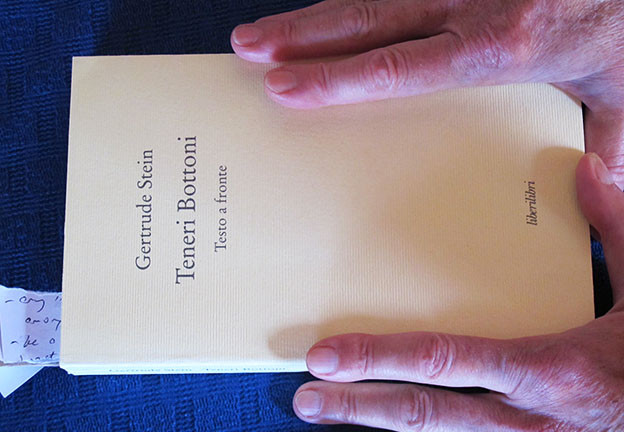Stein's wedding cake

How can Stein’s Tender Buttons be one hundred years old? We are still eating the buttercream frosting and rosebuds from that three-tiered cake: “Objects,” “Food,” “Rooms.”
Tender Buttons — tender (soft) butter, tender (offer) her butter, delicate buds (butons, French), tender buttons, tend her butt, stretch and pull (tendre, a verb in French); soft, delicate, loving, fresh, young (tendre, adjective, French); stretcher, tightener (tendeur, noun, French); layer (tendeur, noun, French) — these associations are only part of the scintillation of the title. The semantic overload is very flouncy.
Tender Buttons is bright with simple words that almost signal something but don’t quite. Stein creates a pulsing signifying process to “suppose” varieties of partially semantic statements composed of just about any language manipulation that can be postulated. There are visual impressions abstractly described, sound associations, trans-lingual puns (“roast potatoes for” — four is “oven” in French), writing from prior writing (nursery rhymes like “pease porridge hot”), slid phonemes, homophonic evocations, expanded or contracted words. The work reads as if translated from English to English, sometimes passing through French and maybe other languages. Yet no tactic is patterned, nothing can be gotten used to, nothing “organically” recurs. Stein challenges many normative assumptions about verbal artworks: generic associations, mimetic claims, lexical certainties, and thematic recurrence. She rejects virtually any creation of reading context. Everything is new at every moment. It is X-treme modernism.
Tender Buttons concerns polymirthful desires and bliss-in-language. It is a fond appropriation of the rhetorical cadences of women’s fashion and advice magazine. Dresses and accessories, umbrellas, materials (feathers, cotton, “eyelet” lace), the pleasures of appreciating and adorning — all recur. The work evokes bodily patterns: orality (food and sound), anality (containing and releasing, mainly in sentence rhythm), and sexuality (in verbal allusions, codes, and puns). “Please butter all the beef-steak” is just one of many images combining vulval and culinary interests (from “Salad dressing and an artichoke”).
Yet if Tender Buttons appears to be a feminine or femme text, still some sentence tones use syntactic cues that mimic other rhythms of conviction — postulates and definitions, masculine in cultural stereotype. I mean categorical statements such as “it is so rudimentary to be analysed” (“A box”); “This is not tardy” (“A time to eat”); “It is surely cohesive” (“A feather”); and sometimes rhetorical condescension: “A table means does it not my dear it means” (“A table”). Stein deploys forensic rhythms of argument: “Why should that which is” or “If there could be that which is contained” (“Roastbeef”) or “If the persecution is so outrageous that nothing is solemn is there any occasion for persuasion” (“Breakfast”).
Adding these gender-evocative rhetorical modes together, let’s conclude that this is an androgynous or queer text, by virtue of the charming instability and incessant looping between masculine and feminine styles, although the feminine predominates and is lovingly valued. Stein wants to make gender and sexuality float unfixed, beyond rigid assignments of male/female, masculine/feminine. Tender Buttons emerges from a “third” place: it is écriture polysexuelle.